Coffee (Liberian)
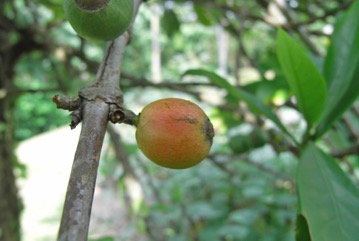
A tropical plant. It suits the hot, wet, lowland tropics. It requires heavy rainfall and high temperatures. It benefits from light shade. It can grow on a range of soils, including poor soils. It can grow in temperatures between 18-28°C. It cannot tolerate frost. It grows naturally in Liberia in West Africa. It grows up to 1,200 m above sea level. In Yunnan.
Also known as:
Cofeeiro, Kopi liberia, Liberian coffee
Synonyms
- Many, Coffea abeokutae Cramer
- Coffea klainei Pierre ex De Wild.
- Coffea excelsa A. Chev.
- Coffea dewevrei de Wild. & Th. Dur.
Edible Portion
- Seeds - coffee
Where does Coffee (Liberian) grow?
Found in: Africa, Angola, Asia, Australia, Cameroon, Central Africa, Central America, China, Congo DR, Costa Rica, Côte d'Ivoire, Cuba, East Africa, East Timor, Fiji, Gabon, Ghana, Grenada, Guam, Guianas, Guinea, Guinée, Guinea-Bissau, Guyana, Hawaii, India, Indochina, Indonesia, Ivory Coast, Liberia, Malaysia, Mozambique, Myanmar, Nigeria, Pacific, Papua New Guinea, PNG, Philippines, Rotuma, Sao Tome and Principe, SE Asia, Sierra Leone, Singapore, South Africa, Southern Africa, South America, Suriname, Thailand, Timor-Leste, Trinidad, United States, Venezuela, Wallis and Futuna, West Africa
Notes: There are about 40 Coffea species.
Growing Coffee (Liberian)
Cultivation: Plants are grown from seed. Seed breed fairly true. The seed are put in a nursery and planted out at 4 m x 4 m spacing. Trees are often not pruned. Sometimes the plants are topped at 2 m and excessive side branches removed. Usually fruit are dried on the tree and processed by dry methods. The seeds have a hard shell making it more difficult to remove than Arabican coffee. Plants can also be grown from cuttings or by grafting.
Edible Uses: The seeds make a bitter drink. They are roasted.
Production: Flowering occurs at irregular intervals but not in flushes. Fruit mature one year after flowering. Fruit of various stages of ripeness are found on the one tree. Plants are cross pollinated.
Nutrition Info
per 100g edible portion| Edible Part | Energy (kcal) | Protein (g) | Iron (mg) | Vitamin A (ug) | Vitamin c (mg) | Zinc (mg) | % Water |
|---|---|---|---|---|---|---|---|
| - | - | - | - | - | - |
Coffee (Liberian) Photos

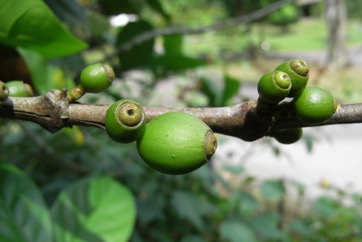
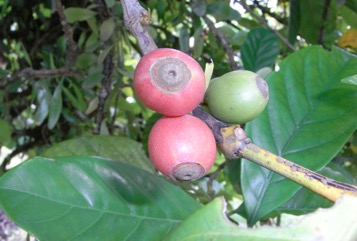
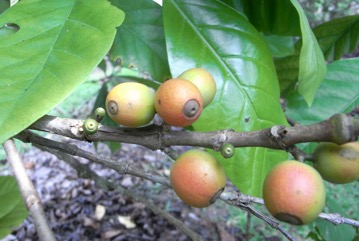
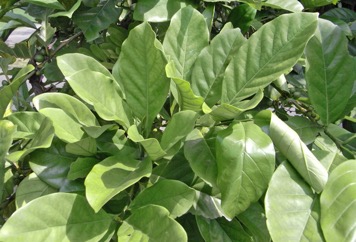
References
Ambasta, S.P. (Ed.), 2000, The Useful Plants of India. CSIR India. p 135
Anderson, E. F., 1993, Plants and people of the Golden Triangle. Dioscorides Press. p 207
Bodkin, F., 1991, Encyclopedia Botanica. Cornstalk publishing, p 271
Bodner, C. C. and Gereau, R. E., 1988, A Contribution to Bontoc Ethnobotany. Economic Botany, 43(2): 307-369
Brouk, B., 1975, Plants Consumed by Man. Academic Press, London. p 346
Burkill, I.H., 1966, A Dictionary of the Economic Products of the Malay Peninsula. Ministry of Agriculture and Cooperatives, Kuala Lumpur, Malaysia. Vol 1 (A-H) p 635
Cooper, W. and Cooper, W., 2004, Fruits of the Australian Tropical Rainforest. Nokomis Editions, Victoria, Australia. p 438
Cundall, P., (ed.), 2004, Gardening Australia: flora: the gardener's bible. ABC Books. p 400
Dalziel, J. M., 1937, The Useful plants of west tropical Africa. Crown Agents for the Colonies London.(Also as Coffea excelsa)
Facciola, S., 1998, Cornucopia 2: a Source Book of Edible Plants. Kampong Publications, p 212
Ferwerda, F.P., 1979, Coffees, in Simmonds, N.W., (ed), Crop Plant Evolution. Longmans. London. p 257
Hedrick, U.P., 1919, (Ed.), Sturtevant's edible plants of the world. p 209
Hu, Shiu-ying, 2005, Food Plants of China. The Chinese University Press. p 680
Lyle, S., 2006, Discovering fruit and nuts. Land Links. p 151
Miguel, E., et al, 1989, A checklist of the cultivated plants of Cuba. Kulturpflanze 37. 1989, 211-357
Purseglove, J.W., 1968, Tropical Crops Dicotyledons, Longmans. p 488
Ruiters-Welcome, A. K., 2019, Food plants of southern Africa. Ph.D. thesis. Univ. of Johannesburg p 96
Small, E., 2009, Top 100 Food Plants. The world's most important culinary crops. NRC Research Press. p 207
Sukarya, D. G., (Ed.) 2013, 3,500 Plant Species of the Botanic Gardens of Indonesia. LIPI p 616
Trans. Linn. Soc. London, Bot. ser. 2, 1:171, t. 24. 1876
World Checklist of Useful Plant Species 2020. Royal Botanic Gardens, Kew
Zuchowski W., 2007, Tropical Plants of Costa Rica. A Zona Tropical Publication, Comstock Publishing. p 195